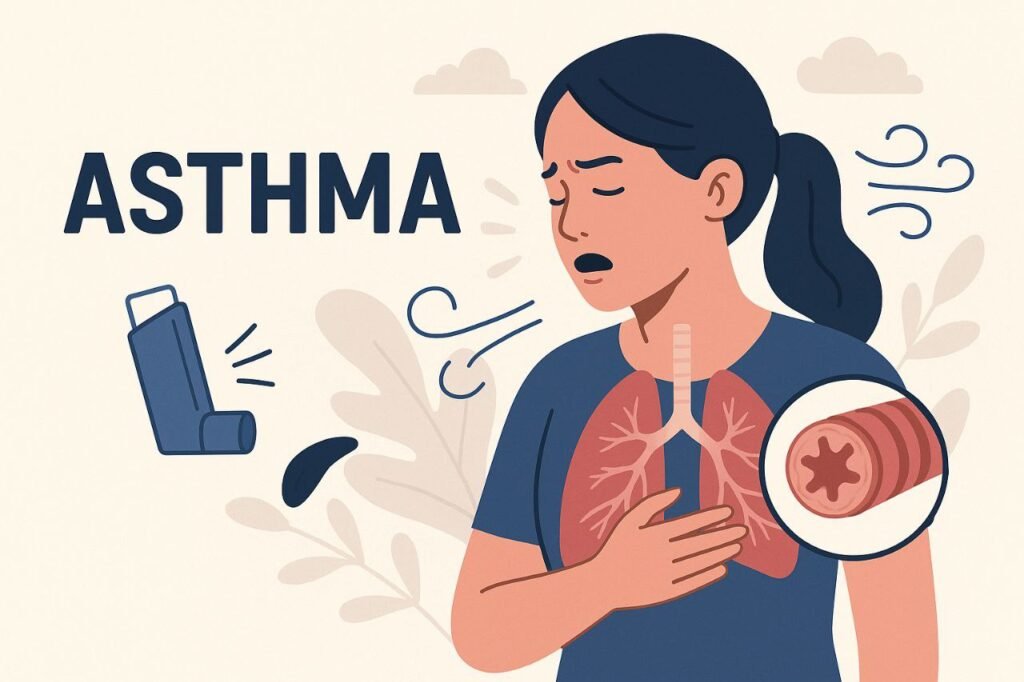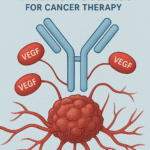Introduction
Asthma is a chronic respiratory condition that affects the airways in the lungs, causing inflammation and narrowing. This leads to symptoms such as coughing, wheezing, shortness of breath, and chest tightness. Asthma can vary in severity, with some individuals experiencing mild symptoms while others face life-threatening attacks. Although asthma cannot be cured, it can be managed effectively with medications, lifestyle adjustments, and avoiding triggers like allergens, pollution, and smoke. It is a significant health concern worldwide, particularly in low- and middle-income countries where under-diagnosis and under-treatment are common. In this article we will study types of asthma, causes and risk factors, symptoms, diagnosis and treatment.

What is Asthma?
Asthma is a chronic respiratory condition characterized by inflammation and narrowing of the airways in the lungs. This leads to difficulty in breathing, accompanied by symptoms such as wheezing, coughing, chest tightness, and shortness of breath. It is a long-term condition that can vary in severity and frequency, with some individuals experiencing occasional mild symptoms and others facing persistent, severe episodes. Asthma is often triggered by allergens, environmental factors, exercise, or respiratory infections. While it cannot be cured, it can be effectively managed with proper treatment and lifestyle adjustments.
How Asthma Affects the Respiratory System
Asthma primarily impacts the lower respiratory tract, including the bronchi and bronchioles, which are responsible for carrying air in and out of the lungs. Here’s how it affects the respiratory system:
- Inflammation: The lining of the airways becomes swollen, reducing the space available for air to pass through.
- Bronchospasm: The muscles around the airways tighten, further narrowing the air passages.
- Excess Mucus Production: The inflamed airways produce thick mucus, which can clog the airways and exacerbate breathing difficulties.
- Impaired Gas Exchange: The narrowing of airways and mucus buildup hinder the efficient exchange of oxygen and carbon dioxide, leading to shortness of breath and fatigue.
These effects can cause asthma attacks, where breathing becomes significantly more difficult. If untreated, severe asthma attacks can be life-threatening.
Common Myths and Misconceptions About Asthma
- Asthma is Just a Childhood Disease: While asthma often begins in childhood, it can develop at any age, including adulthood.
- Asthma is Contagious: Asthma is not an infectious disease and cannot be spread from person to person.
- Asthma Medications Are Addictive: Inhalers and other asthma medications are not addictive; they are essential for managing the condition.
- Asthma Can Be Cured: There is no cure for asthma, but it can be effectively controlled with proper treatment and lifestyle changes.
- People with Asthma Should Avoid Exercise: With proper management, individuals with asthma can engage in physical activities, and exercise can even improve lung function over time.
- Asthma is a Minor Inconvenience: Severe asthma can significantly impact quality of life and, in extreme cases, can be fatal if not managed properly.
These misconceptions can lead to stigma and inadequate treatment, so raising awareness is crucial for better management and understanding of asthma.
Types of Asthma
Asthma can be classified into several types based on triggers, symptoms, and underlying causes. Here’s a detailed explanation of the common types:
- Allergic Asthma: This is the most common type, triggered by allergens such as pollen, dust mites, pet dander, or mold. It often starts in childhood and is associated with a family history of allergies. Symptoms may include sneezing, nasal congestion, and itchy eyes along with asthma symptoms.
- Non-Allergic Asthma: Unlike allergic asthma, this type is not triggered by allergens. It is often caused by factors like stress, extreme weather conditions, respiratory infections, or air pollution. It is more common in adults and may develop later in life.
- Exercise-Induced Asthma: This type occurs during or after physical activity, especially in cold or dry air. Symptoms include shortness of breath, wheezing, and chest tightness. It can affect individuals with or without other types of asthma.
- Occupational Asthma: Caused by exposure to irritants in the workplace, such as chemicals, dust, or fumes. Symptoms often improve when the individual is away from the workplace.
- Aspirin-Induced Asthma: Triggered by non-steroidal anti-inflammatory drugs (NSAIDs) like aspirin. It is often accompanied by nasal polyps and sinus infections.
- Seasonal Asthma: Symptoms occur during specific seasons, often due to allergens like pollen or changes in weather.
Comparison Table
| Type of Asthma | Triggers | Common Characteristics | Affected Groups |
| Allergic Asthma | Allergens (pollen, dust mites, etc.) | Associated with allergies; sneezing, itchy eyes | Common in children |
| Non-Allergic Asthma | Stress, weather, infections | Not linked to allergens; develops later in life | More common in adults |
| Exercise-Induced Asthma | Physical activity, cold air | Symptoms during/after exercise | Can affect anyone |
| Occupational Asthma | Workplace irritants (chemicals, dust) | Symptoms improve away from workplace | Adults in specific jobs |
| Aspirin-Induced Asthma | NSAIDs (aspirin, ibuprofen) | Often with nasal polyps and sinus infections | Adults |
| Seasonal Asthma | Pollen, weather changes | Symptoms during specific seasons | Varies |
Causes of Asthma
Asthma is a complex condition with no single cause. It results from a combination of genetic, environmental, and lifestyle factors. Here are the primary causes:
- Genetic Factors:
- A family history of asthma, allergies, or other atopic conditions (e.g., eczema, hay fever) increases the likelihood of developing asthma.
- Specific genetic variations can influence the immune system’s response to allergens.
- Environmental Triggers:
- Allergens: Pollen, dust mites, mold, pet dander, and cockroach droppings are common triggers.
- Air Pollution: Exposure to pollutants like vehicle emissions, industrial fumes, and smoke can irritate the airways.
- Weather Conditions: Cold air, humidity, or sudden temperature changes can provoke asthma symptoms.
- Respiratory Infections:
- Viral infections, especially during childhood, can damage lung tissues and increase asthma susceptibility.
- Occupational Exposure:
- Certain jobs expose individuals to irritants like chemicals, dust, or fumes, leading to occupational asthma.
- Lifestyle Factors:
- Smoking or exposure to secondhand smoke is a significant risk factor.
- Obesity can worsen asthma symptoms due to increased inflammation and reduced lung function.
Risk Factors for Asthma
Several factors increase the risk of developing asthma or exacerbating its symptoms:
- Age: Asthma often begins in childhood, but it can develop at any age.
- Gender: In children, asthma is more common in boys, while in adults, it is more prevalent in women.
- Allergies: Individuals with other allergic conditions, such as eczema or allergic rhinitis, are at higher risk.
- Family History: A close relative with asthma or allergies increases the likelihood of developing asthma.
- Exposure to Irritants: Long-term exposure to irritants like smoke, pollution, or occupational chemicals can lead to asthma.
- Socioeconomic Factors: Limited access to healthcare and living in areas with high pollution levels can increase asthma risk.
- Stress and Emotional Factors: Stress and strong emotions can trigger asthma symptoms in some individuals.
- Diet: A diet low in fruits and vegetables, which are rich in antioxidants, may increase susceptibility to asthma.
Symptoms of Asthma
Asthma symptoms can vary in severity and frequency from person to person. Here are the common symptoms:
- Shortness of Breath:
- Difficulty breathing, especially during physical activity or at night.
- Feeling like you can’t get enough air.
- Wheezing:
- A whistling or squeaky sound when exhaling.
- Often more noticeable during asthma attacks.
- Coughing:
- Persistent coughing, especially at night or early morning.
- Coughing may worsen with exercise or exposure to triggers.
- Chest Tightness or Pain:
- A sensation of pressure or constriction in the chest.
- Can feel like a heavy weight on the chest.
- Trouble Sleeping:
- Difficulty sleeping due to coughing, wheezing, or shortness of breath.
- Asthma Attacks:
- Episodes where symptoms worsen significantly.
- May include rapid breathing, severe wheezing, and inability to speak in full sentences.
Signs of Worsening Asthma
- Increased frequency and intensity of symptoms.
- Difficulty breathing even with medication.
- Need for quick-relief inhalers more often.
Asthma Triggers
Symptoms can flare up due to triggers such as:
- Allergens (pollen, dust mites, pet dander).
- Air pollution or smoke.
- Respiratory infections.
- Cold air or sudden weather changes.
- Stress or strong emotions.
Differences in Asthma Symptoms Across Age Groups
Asthma symptoms manifest differently in children, adults, and the elderly due to variations in physiology, immune response, and environmental factors. Here’s a detailed breakdown:
Children
- Symptoms: Wheezing, coughing (especially at night), and shortness of breath are common. Children may also experience recurrent respiratory infections.
- Triggers: Allergens like pollen, dust mites, and pet dander are frequent triggers. Viral infections are also a significant cause of asthma exacerbations in children.
- Severity: Symptoms may come and go, with many children experiencing remission as they grow older.
- Challenges: Diagnosing asthma in young children can be difficult due to overlapping symptoms with other respiratory conditions like bronchiolitis.
Adults
- Symptoms: Persistent coughing, wheezing, and chest tightness. Adults often experience chronic symptoms that are less likely to go into remission.
- Triggers: Stress, smoking, occupational irritants, and hormonal changes (e.g., during pregnancy) can exacerbate asthma.
- Severity: Adult-onset asthma tends to be more severe and less responsive to treatment compared to childhood asthma.
- Challenges: Adults may have coexisting conditions like obesity or heart disease that complicate asthma management.
Elderly
- Symptoms: Shortness of breath and wheezing are prominent, but coughing may be less noticeable. Symptoms can be mistaken for other age-related conditions like chronic obstructive pulmonary disease (COPD).
- Triggers: Cold air, respiratory infections, and medications for other health conditions can worsen asthma.
- Severity: Asthma in the elderly is often underdiagnosed and undertreated, leading to a higher risk of severe attacks.
- Challenges: Reduced lung function and difficulty using inhalers due to arthritis or cognitive decline can hinder effective treatment.
Comparison Table
| Age Group | Common Symptoms | Triggers | Challenges |
| Children | Wheezing, night coughing, infections | Allergens, viral infections | Overlapping symptoms with other conditions |
| Adults | Persistent coughing, chest tightness | Stress, smoking, occupational irritants | Coexisting conditions like obesity |
| Elderly | Shortness of breath, wheezing | Cold air, respiratory infections | Reduced lung function, difficulty using inhalers |
How Asthma is Diagnosed
Asthma diagnosis involves a combination of medical history, physical examination, and specialized tests to confirm the condition and rule out other respiratory issues. Here are the key methods:
Medical History
- Symptoms: The doctor will ask about symptoms such as wheezing, coughing, shortness of breath, and chest tightness.
- Triggers: Questions about potential triggers like allergens, exercise, or infections.
- Family History: A history of asthma, allergies, or other atopic conditions in the family.
- Lifestyle Factors: Smoking habits, exposure to secondhand smoke, or occupational irritants.
Physical Examination
- Lung and Chest Examination: The doctor listens for wheezing or other abnormal sounds in the lungs.
- Signs of Allergies: Checking for nasal congestion, skin rashes, or other allergy-related symptoms.
Lung Function Tests
These tests measure how well the lungs are working:
- Spirometry: Measures the amount of air you can exhale after a deep breath and how quickly you can do it. It helps detect airway narrowing.
- Peak Flow Test: Uses a peak flow meter to measure how hard you can breathe out. Lower readings may indicate asthma.
- Bronchodilator Reversibility Test: Spirometry is repeated after using a bronchodilator (a medication that opens airways). Improvement in lung function confirms asthma.
Allergy Testing
- Skin Prick Test: Identifies specific allergens that may trigger asthma symptoms.
- Blood Tests: Measures levels of immunoglobulin E (IgE) and eosinophils, which are associated with allergic reactions.
Methacholine Challenge Test
- Methacholine is a substance that causes mild airway narrowing. If inhaling it triggers asthma symptoms, the diagnosis is confirmed.
Imaging Tests
- Chest X-Ray: Helps rule out other conditions like infections or structural abnormalities.
- CT Scan: Provides detailed images of the lungs if needed.
Exhaled Nitric Oxide Test
- Measures the level of nitric oxide in your breath. Higher levels indicate airway inflammation, a hallmark of asthma.
Sputum Eosinophils Test
- Examines the presence of eosinophils (a type of white blood cell) in the mucus you cough up. High levels suggest asthma.
Exercise and Cold-Induced Asthma Tests
- The doctor measures lung function before and after vigorous exercise or exposure to cold air to check for exercise-induced asthma.
Treatment and Management of Asthma
Asthma management focuses on controlling symptoms, preventing exacerbations, and improving quality of life. Here’s a detailed breakdown:
Medications
Asthma medications are categorized into two main types: quick-relief and long-term control.
- Quick-Relief Medications:
- Short-Acting Beta-Agonists (SABAs): These bronchodilators, such as albuterol, provide immediate relief by relaxing airway muscles.
- Anticholinergics: Medications like ipratropium help reduce mucus production and open airways during acute attacks.
- Long-Term Control Medications:
- Inhaled Corticosteroids (ICS): The most effective long-term treatment to reduce airway inflammation (e.g., budesonide, fluticasone).
- Long-Acting Beta-Agonists (LABAs): Used in combination with ICS to maintain open airways (e.g., salmeterol, formoterol).
- Leukotriene Modifiers: Oral medications like montelukast block inflammatory chemicals and are especially useful for allergic asthma.
- Biologics: Targeted therapies like omalizumab (anti-IgE) and mepolizumab (anti-IL-5) are used for severe asthma cases.
- Theophylline: A less commonly used oral medication that helps relax airway muscles.
- Emergency Medications:
- Oral or intravenous corticosteroids (e.g., prednisone) are used during severe asthma attacks.
Lifestyle Modifications
Lifestyle changes play a crucial role in managing asthma effectively:
- Avoiding Triggers:
- Identify and minimize exposure to allergens (e.g., pollen, dust mites) and irritants (e.g., smoke, pollution).
- Regular Exercise:
- Engage in moderate physical activity to improve lung function, but take precautions for exercise-induced asthma.
- Healthy Diet:
- A diet rich in fruits, vegetables, and omega-3 fatty acids can reduce inflammation.
- Weight Management:
- Maintaining a healthy weight helps reduce asthma severity, especially in obese individuals.
- Breathing Exercises:
- Techniques like yoga and pranayama can improve lung capacity and reduce stress.
- Quit Smoking:
- Avoid smoking and exposure to secondhand smoke to prevent airway irritation.
Role of Immunotherapy
Immunotherapy is a promising approach for managing asthma, particularly allergic asthma:
- Allergen-Specific Immunotherapy (AIT):
- Involves administering gradually increasing doses of allergens to desensitize the immune system.
- Delivered through subcutaneous injections (SCIT) or sublingual tablets (SLIT).
- Benefits:
- Reduces sensitivity to allergens, leading to fewer symptoms and less reliance on medications.
- Provides long-term improvement and may prevent the progression of allergic diseases.
- Limitations:
- Requires a long-term commitment (3–5 years) and is not suitable for all asthma patients.
Living with asthma
Living with asthma involves managing breathing difficulties such as wheezing, coughing, and shortness of breath, which can sometimes limit physical activities and disrupt daily life. Emotional challenges like stress and anxiety may arise due to the unpredictability of symptoms, but proper treatment—including medication adherence, avoiding triggers, and following a personalized asthma action plan—can help control the condition effectively. Support systems, education, and a proactive approach play vital roles in improving quality of life, enabling many individuals with asthma to lead active, healthy, and fulfilling lives.
Preventive measures
Preventing asthma involves reducing exposure to triggers, maintaining a healthy lifestyle, and taking proactive measures to minimize the risk of asthma attacks. Here are some key preventive strategies:
- Avoiding Triggers
- Allergens: Minimize exposure to pollen, dust mites, pet dander, and mold by keeping your living space clean and using air purifiers.
- Smoke: Avoid smoking and exposure to secondhand smoke, as well as smoke from candles, incense, and fireworks.
- Pollution: Limit outdoor activities during high pollution days and use masks if necessary.
- Maintaining Good Respiratory Health
- Vaccinations: Get vaccinated against influenza and pneumonia to reduce the risk of respiratory infections that can worsen asthma.
- Hygiene: Practice good hygiene, such as frequent handwashing, to prevent infections.
- Lifestyle Modifications
- Healthy Diet: Consume a balanced diet rich in fruits, vegetables, and omega-3 fatty acids to reduce inflammation.
- Regular Exercise: Engage in moderate physical activity to improve lung function, but take precautions if you have exercise-induced asthma.
- Weight Management: Maintain a healthy weight to reduce the strain on your respiratory system.
- Managing Allergies
- Immunotherapy: Consider allergen-specific immunotherapy (e.g., allergy shots) to desensitize your immune system to specific triggers.
- Medication: Use prescribed antihistamines or nasal sprays to manage allergies effectively.
- Environmental Control
- Air Quality: Use HEPA filters in air purifiers and vacuum cleaners to remove allergens from the air.
- Humidity Control: Maintain indoor humidity levels between 40% and 50% to prevent mold growth.
- Asthma Action Plan
- Work with your healthcare provider to develop a personalized asthma action plan that includes recognizing early warning signs and taking appropriate steps to prevent attacks.
The future of asthma treatment
The future of asthma treatment is promising, with several advancements and potential breakthroughs on the horizon:
- Smart Inhalers
- Smart inhalers equipped with sensors are revolutionizing asthma management. These devices track medication usage and provide real-time feedback to patients and healthcare providers, improving adherence and optimizing treatment outcomes.
- Biologic Therapies
- Biologic drugs like benralizumab and amlitelimab are showing significant potential in treating severe asthma. These therapies target specific inflammatory pathways, reducing the need for high-dose steroids and minimizing side effects.
- Amlitelimab, for instance, has demonstrated clinically meaningful reductions in asthma exacerbations and improved lung function in clinical trials. It offers a long-acting treatment option with infrequent dosing schedules.
- Personalized Medicine
- Advances in genetic research and biomarker identification are paving the way for personalized asthma treatments. Tailored therapies based on an individual’s genetic profile and specific triggers can enhance treatment efficacy and reduce unnecessary medication use.
- Non-Invasive Monitoring
- Emerging technologies like exhaled nitric oxide monitors and wearable devices are enabling non-invasive monitoring of airway inflammation and lung function. These tools help in early detection of exacerbations and better disease management.
- Immunotherapy
- Allergen-specific immunotherapy continues to evolve, offering long-term relief for allergic asthma. New delivery methods, such as sublingual tablets, are making immunotherapy more accessible and convenient.
- Research on New Targets
- Scientists are exploring novel targets for asthma treatment, such as OX40-Ligand and eosinophil pathways. These approaches aim to restore immune balance and provide durable relief for patients with severe or treatment-resistant asthma.
- Environmental and Public Health Initiatives
- Efforts to reduce air pollution and improve indoor air quality are critical for asthma prevention and management. Governments and organizations are increasingly focusing on policies to address environmental triggers.
Conclusion
Asthma is a chronic respiratory condition characterized by airway inflammation and narrowing, resulting in symptoms like wheezing, coughing, shortness of breath, and chest tightness. It can manifest differently across age groups, with children often experiencing wheezing and coughing due to allergens and respiratory infections, adults facing persistent symptoms aggravated by stress or occupational irritants, and elderly individuals dealing with shortness of breath and reduced lung function, often complicated by coexisting conditions. Diagnosis involves a combination of medical history, physical exams, and tests like spirometry, allergy testing, and imaging to confirm asthma and rule out other conditions. Treatment includes quick-relief medications like bronchodilators for acute symptoms, long-term control medications like inhaled corticosteroids and biologics for severe cases, and lifestyle modifications such as avoiding triggers, maintaining a healthy diet, exercising, and practicing breathing exercises like yoga and pranayama. Immunotherapy offers promising long-term relief for allergic asthma through desensitization techniques like subcutaneous injections or sublingual tablets. Living with asthma requires medication adherence, an asthma action plan, and support systems to improve quality of life and overcome physical and emotional challenges. Preventive measures include minimizing exposure to allergens and irritants, maintaining good respiratory health through vaccinations, and adopting a healthy lifestyle with regular exercise and balanced nutrition. The future outlook for asthma treatment is promising, with advancements like smart inhalers, biologic therapies targeting inflammatory pathways, personalized medicine, and improved non-invasive monitoring techniques offering enhanced management and patient outcomes. Raising awareness about asthma and seeking timely medical help are crucial for effective treatment, prevention, and addressing the stigma associated with the condition, highlighting the need for collective action to combat asthma’s impact on individuals and communities.
For more regular updates you can visit our social media accounts,
Instagram: Follow us
Facebook: Follow us
WhatsApp: Join us
Telegram: Join us



